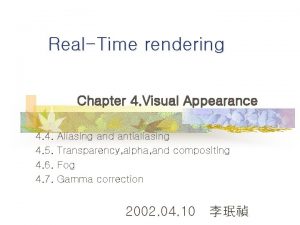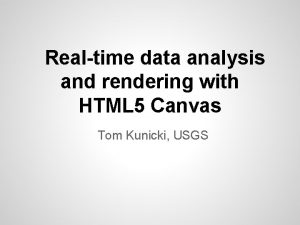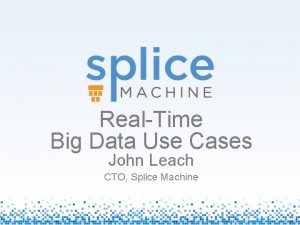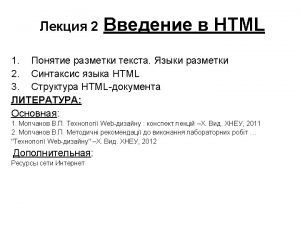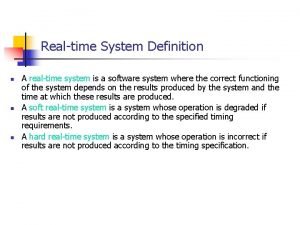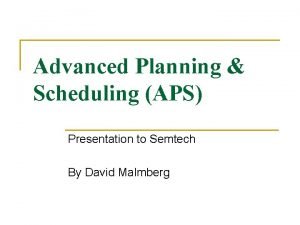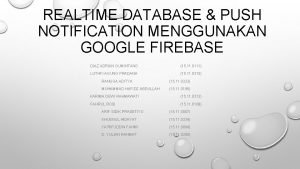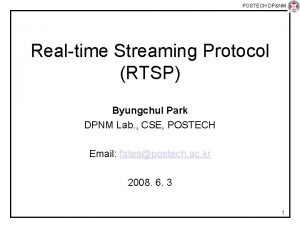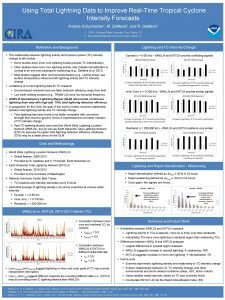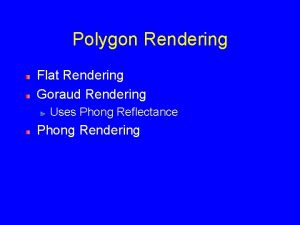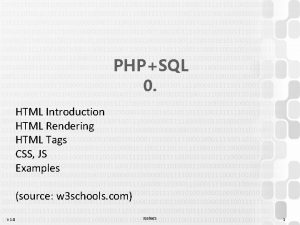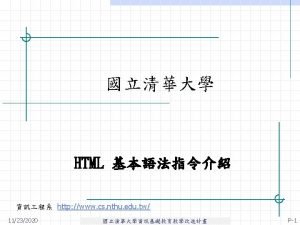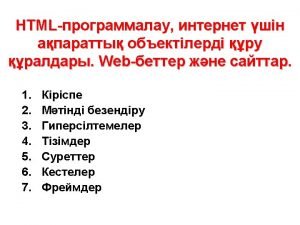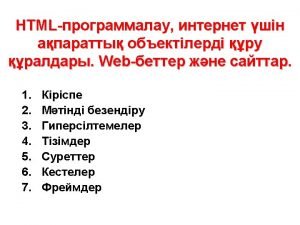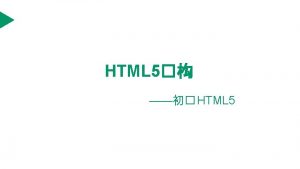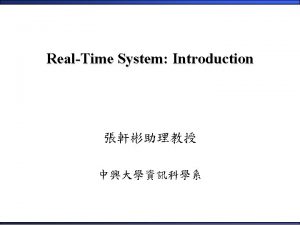Realtime data analysis and rendering with HTML 5



















- Slides: 19

Real-time data analysis and rendering with HTML 5 Canvas Tom Kunicki, USGS

Introduction • Work initiated with 2012 CDI Project Tim Schaub (Open. Geo), John Aguinaldo (USGS) o Presented HTML 5 rendering pipeline o • Current work Optimization of rendering pipeline o Bundled as simple extension to Open. Layers o Developed method for vending quantitative data § Standards-based § Open source o

Existing Methods • Single Tile Rendering Map overlay image requested as single tile o Single image covers map extent o New tile for each pan, zoom or style change o Image caching not possible o

Existing Methods • Multiple Tile Rendering o o Map overlay image requested as multiple tiles Can reuse tiles on pan operation (load new only) New tileset for each zoom level or style change Image caching possible § Requires fixed tiepoint, zoom levels and size and styles

Existing Methods • • • Server-side rendering can be expensive for complex data sets Styling and symbolization is a user preference Changes in styling require client/server round-trip NHDPlus Flowlines for HUC 2 (04) Approximately 114 k features rendered using mean monthly flow for 07/1993 as percentile of historical distribution obtained from results of AFINCH model run. Rendering time 30 seconds.

Presented Method • Tile "pre-rendering" with styling in browser o o Render quantitative information to tiles via WMS § Identifier or primary key § Attribute value Obtain supplemental information via WFS § Restrict to subset of attributes Apply styling in browser § Color maps § Feature culling Benefits § Rendering cost incurred once § Tiles are cacheable • § For a given spatiotemporal tile data doesn't change Responsive rendering

Presented Method • Facilitated by recent advancements o Geo. Server 2. 2. x § Rendering Transforms • • Implemented in Geo. Server 2. 2. x (Sept, 2012) WMS/SLD/WPS integration o Allows for highly customized rendering via WMS § Raster-to-Vector § Vector-to-Raster § Vector-to-Vector § Integrated Tile Caching • • o Seamless integration with WMS Allows for simple use of cache with Open. Layers § HTML 5 rendering pipeline § Sponsored by USGS CDI


Rendering Transform • • Vector-to-Raster rendering transform Implemented as WPS process o o • Available for direct execution Linked to WMS with SLD § Geo. Server specific vendor extension Inputs § WMS request parameters • § Feature collection to render • § bounding box, tile size. . . already clipped to bounding box Attribute to render Attribute for precedence Outputs a Raster

Rendering Transform • For each feature Render feature attribute value to raster pixels o If multiple features intersect pixel use precedence o • Attribute values limited to 24 bits Use RGB channels for data o Alpha value must be 1. 0/0 xff (more on this later) o • Custom Alpha Compositor Disable anti-aliasing o Implement precedence o • Slow, but optimization can be neglected

WFS for supplemental information • • Output in many formats; xml, json Subset request to required attributes Identifier o Provide attributes for browser side rendering o • Typically same datastore but not required o Must share rendered identifier

Tile Caching • • Geo. Web. Cache integrated into Geo. Server Now supports WMS integration Must use tiepoint of (0, 0) o Tile size of 256 x 256 o Standard zoom levels o append "tiled=true" as vendor argument o • Other protocols supported WMS-C, TMS, WMTS o WMS is typically the easiest on client side o • Seed cache for lower zoom levels o Separate cache for each time, style and CRS

HTML 5 Rendering Pipeline • • Create a pipeline to transform pre-rendered data to displayed image data Three components to pipeline WMS composite Layer o Pipeline operations (can be chained) o Rendered Raster Layer o • Based on Open. Layers 2. 12 Not released o Available as extension package bundled by CIDA o

WMS Composite Layer • Open. Layers. Layer. WMS instance o o o specify style utilizing Rendering Transform SLD enable tiling disable visibility specify PNG as image format (lossless) Same-origin or CORS § cross-origin canvas issues on read add to Open. Layers map instance

WMS Composite Layer • Open. Layers. Raster. Composite instance o Create using from. Layer(. . . ) function o Writes the layer tiles to an HTML 5 canvas § required to read image data o Source for pipeline operations o Reminder: Image alpha must be 1. 0/0 x. FF § Canvas will premultiply alpha on write § On read alpha is divided out, this is lossy

Pipeline Operation • Open. Layers. Raster. Operation instance wrap custom function using create(. . . ) method o function can accept up to 3 arguments § function(pixel, x, y) o • o pixel is 4 byte integer optimization is important! § called for every pixel on every rendering pass

Raster Layer • Open. Layers. Layer. Raster instance create o call set. Data(. . . ) using created Operation instance o add to map o • Target of pipeline operations

Sample Code var flowlines. WMSData = new Open. Layers. Layer. WMS( "Flowline WMS (Data)", geoserver. Base. URL + "wms", { layers: flowline. Layer, styles: flowline. Style, format: "image/png", tiled: "true" }, { is. Base. Layer: false, opacity: 0, display. In. Layer. Switcher: false, tile. Options: { cross. Origin. Keyword: 'anonymous' } } ); var flowline. Raster = new Open. Layers. Layer. Raster( { name: "NHD Flowlines”, is. Base. Layer: false }); // NOTE: in code below ‘pixel’ and ‘clip. Value’ are calculated elsewhere // define per-pixel operation var flowline. Clip. Operation = Open. Layers. Raster. Operation. create(function(pixel) { if (pixel >> 24 === 0) { return 0; } var value = pixel & 0 x 00 ffffff; if (value >= clip. Value && value < 0 x 00 ffffff) { return pixel; } else { return 0; } }); // source canvas (writes WMS tiles to canvas for reading) var flowline. Composite = Open. Layers. Raster. Composite. from. Layer(flowlines. WMSData, {int 32: true}); // filter source data through per-pixel operation var flowline. Clip. Operation. Data = flowline. Clip. Operation(flowline. Composite); // define layer that writes data to a new canvas flowline. Raster. set. Data(flowline. Clip. Operation. Data);

Demo http: //localhost: 8080/demo 1/ http: //localhost: 8080/demo 2/ tkunicki@usgs. gov https: //github. com/tkunicki-usgs/glri-geoserver
 Visual rendering
Visual rendering Rendering realtime compositing
Rendering realtime compositing Realtime big data
Realtime big data Doctype html html head
Doctype html html head Slidetodoc.com
Slidetodoc.com Slidetodoc.com
Slidetodoc.com Doctype html html head
Doctype html html head Doctype html html head
Doctype html html head Simple online and realtime tracking
Simple online and realtime tracking Image-based modeling
Image-based modeling Real-time system definition
Real-time system definition Gullistan carpet
Gullistan carpet Firebase push notification android
Firebase push notification android Realtime streaming protocol
Realtime streaming protocol Curis realtime
Curis realtime Market overview real-time interaction management
Market overview real-time interaction management Lightning realtime
Lightning realtime Realtime operating system
Realtime operating system Realtime communications
Realtime communications Realtime it
Realtime it
